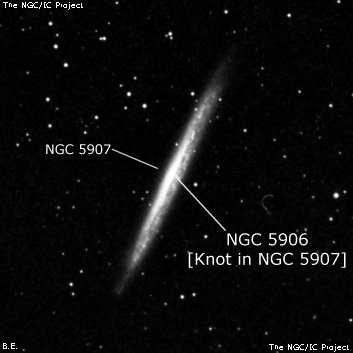
In 1850, Lord Rosse (or an assistant) sketched this part of the galaxy (with an embedded star) extending parallel to the main, brighter eastern side.
George Johnstone Stoney, Lord Rosse's assistant, discovered NGC 5906 on 13 Apr 1850. He description of NGC 5907 mentions a "very remarkable ray, 12' or 15' long,..., a longitudinal split p[receding] nucleus." NGC 5906 refers to the faint slice of the galaxy on the west side of the dust lane, which was shown on his field sketch.
600/800mm - 24" (7/8/13): A thin dust lane on the preceding side of the core of the showpiece edge-on NGC 5907 can be traced at least 5'. NGC 5906 is a thin, low surface brightness strip of the galaxy, parallel to the major axis, that is visible on the west side of the dust lane.
900/1200mm - 48" (4/21/17): at 375x; a sharply defined dust lane slices through the central region of NGC 5907, creating two asymmetric sections with the thin, brighter core section on the eastern side. An easily visible glow is on the western side of the dust lane (catalogued separatedly as NGC 5906), though it has a much lower surface brightness.
Notes by Steve Gottlieb